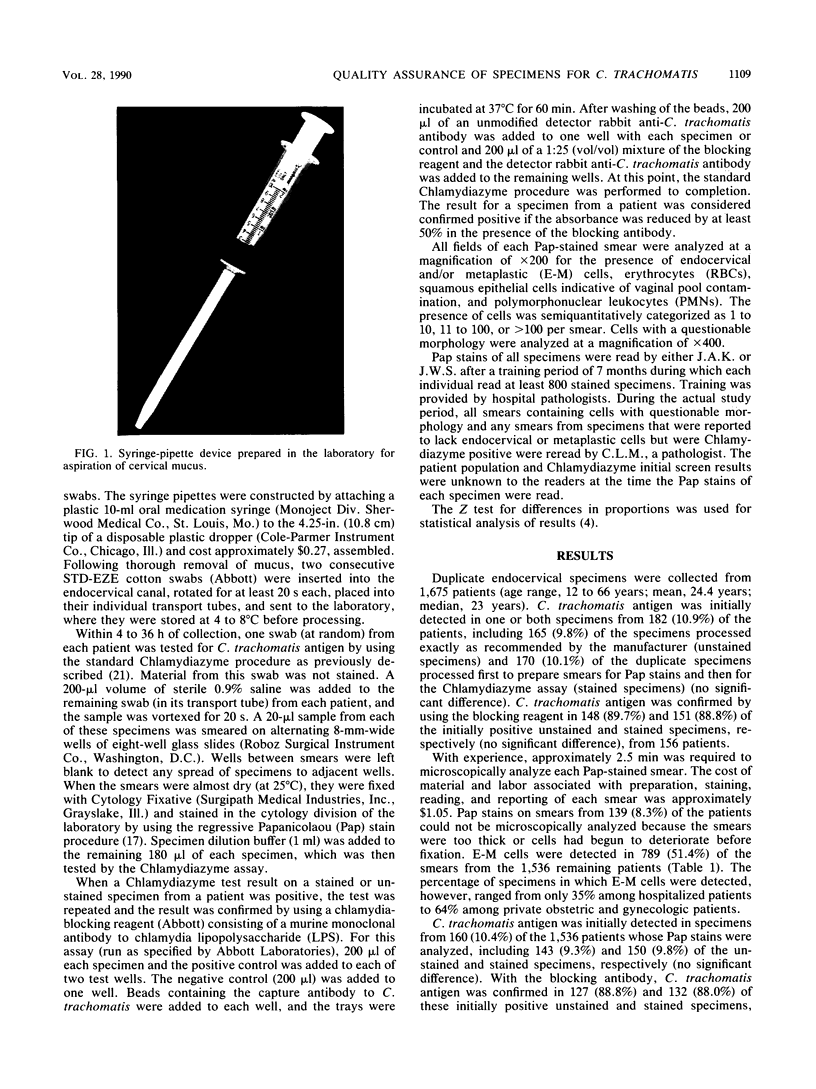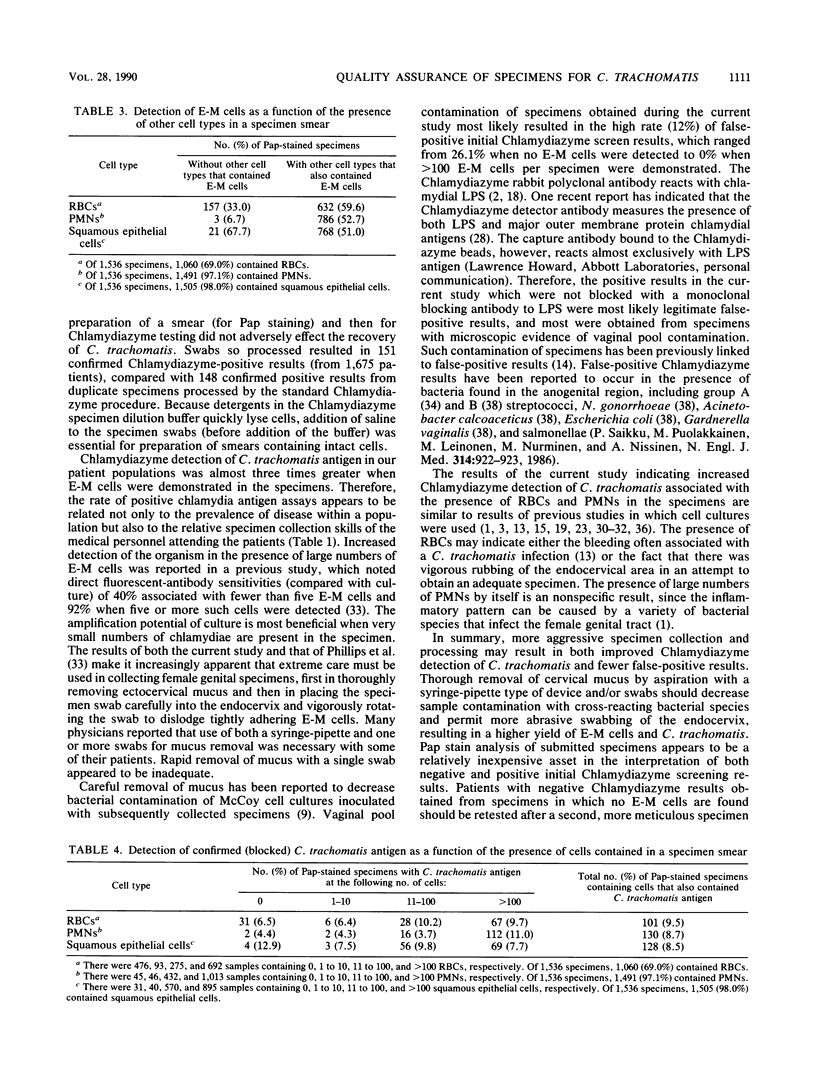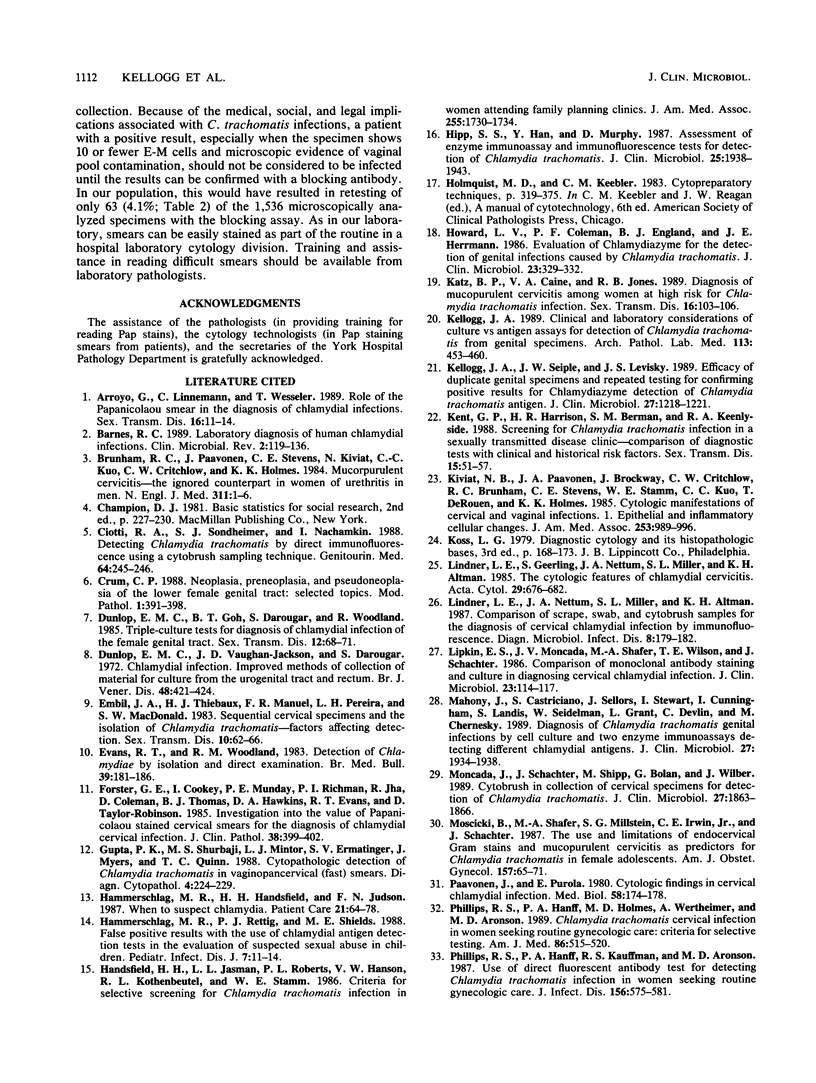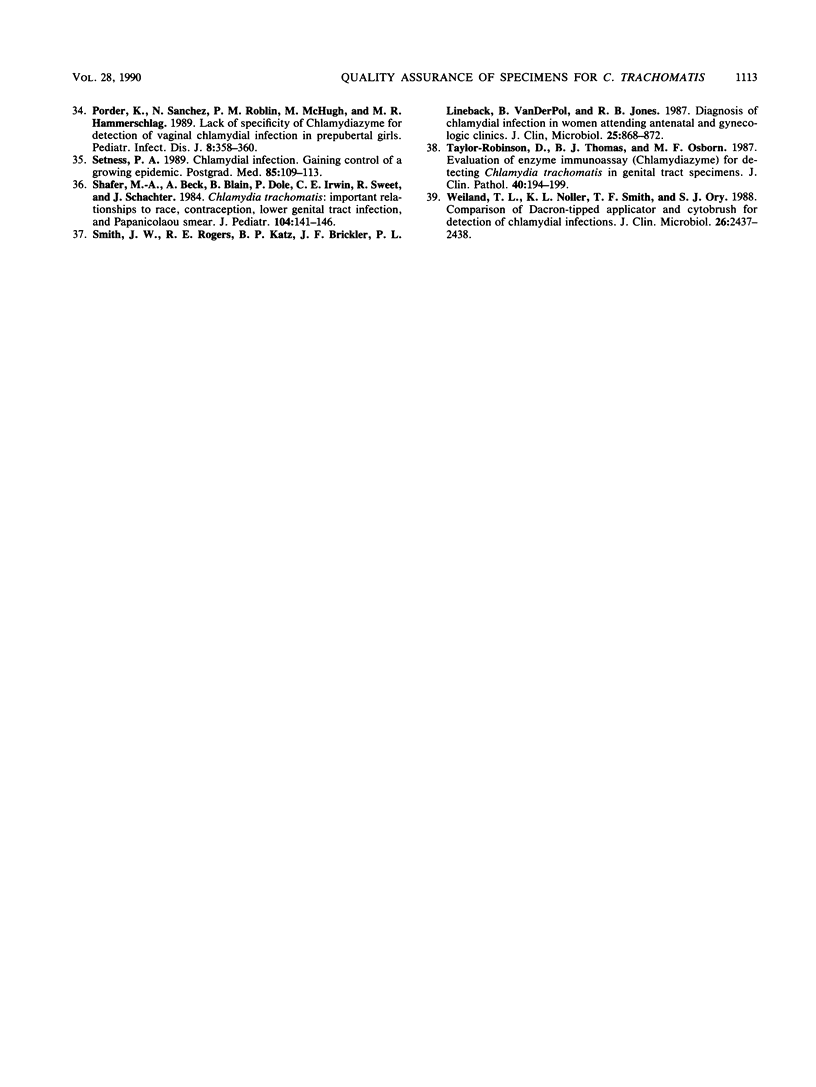Abstract
Duplicate endocervical swabs were collected from 1,675 patients to assess the effects of variations in specimen quality on Chlamydiazyme (Abbott Laboratories) detection of Chlamydia trachomatis and the incidence of false-positive results. One swab (at random) from each patient was tested for C. trachomatis antigen by using the standard Chlamydiazyme procedure. A 200-microliter volume of 0.9% saline was added to the other swab from each patient. After vortexing, 20 microliters was smeared on a slide for Papanicolaou (Pap) staining and the remaining specimen was then tested with the Chlamydiazyme assay. The Chlamydiazyme result was positive for 170 (10.1%) and 165 (9.8%) of the stained and unstained duplicate specimens, respectively (no significant difference). Pap stains on smears from 1,536 (91.7%) of the patients were analyzed, and endocervical and/or metaplastic (E-M) cells were detected in 789 (51.4%) smears. Of these 1,536 stained and analyzed specimens, 150 (9.8%) were Chlamydiazyme positive but only 132 (88.0%) of the positive results were confirmed by repeating the test and using a monoclonal blocking antibody (Abbott). Confirmed Chlamydiazyme-positive results were obtained from only 34 (4.6%) of 747 specimens lacking E-M cells but from 98 (12.4%) of 789 specimens containing the cells (P less than 0.001). Of the 150 initially Chlamydiazyme-positive results obtained with Pap-stained, analyzed specimens, 12 (26.1%) of 46 were falsely positive from specimens lacking E-M cells but only 6 (5.8%) of 104 were falsely positive from specimens containing E-M cells (P less than 0.01). C. trachomatis antigen was detected significantly more frequently and false-positive results were significantly less common from specimens in which E-M cells were detected.
Full text
PDF





Images in this article
Selected References
These references are in PubMed. This may not be the complete list of references from this article.
- Arroyo G., Linnemann C., Wesseler T. Role of the Papanicolaou smear in diagnosis of chlamydial infections. Sex Transm Dis. 1989 Jan-Mar;16(1):11–14. doi: 10.1097/00007435-198901000-00003. [DOI] [PubMed] [Google Scholar]
- Barnes R. C. Laboratory diagnosis of human chlamydial infections. Clin Microbiol Rev. 1989 Apr;2(2):119–136. doi: 10.1128/cmr.2.2.119. [DOI] [PMC free article] [PubMed] [Google Scholar]
- Brunham R. C., Paavonen J., Stevens C. E., Kiviat N., Kuo C. C., Critchlow C. W., Holmes K. K. Mucopurulent cervicitis--the ignored counterpart in women of urethritis in men. N Engl J Med. 1984 Jul 5;311(1):1–6. doi: 10.1056/NEJM198407053110101. [DOI] [PubMed] [Google Scholar]
- Ciotti R. A., Sondheimer S. J., Nachamkin I. Detecting Chlamydia trachomatis by direct immunofluorescence using a Cytobrush sampling technique. Genitourin Med. 1988 Aug;64(4):245–246. doi: 10.1136/sti.64.4.245. [DOI] [PMC free article] [PubMed] [Google Scholar]
- Crum C. P. Neoplasia, preneoplasia, and pseudoneoplasia of the lower female genital tract: selected topics. Mod Pathol. 1988 Sep;1(5):391–398. [PubMed] [Google Scholar]
- Dunlop E. M., Goh B. T., Darougar S., Woodland R. Triple-culture tests for diagnosis of chlamydial infection of the female genital tract. Sex Transm Dis. 1985 Apr-Jun;12(2):68–71. doi: 10.1097/00007435-198504000-00003. [DOI] [PubMed] [Google Scholar]
- Dunlop E. M., Vaughan-Jackson J. D., Darougar S. Chlamydial infection. Improved methods of collection of material for culture from the urogenital tract and rectum. Br J Vener Dis. 1972 Dec;48(6):421–424. doi: 10.1136/sti.48.6.421. [DOI] [PMC free article] [PubMed] [Google Scholar]
- Embil J. A., Thiébaux H. J., Manuel F. R., Pereira L. H., MacDonald S. W. Sequential cervical specimens and the isolation of Chlamydia trachomatis: factors affecting detection. Sex Transm Dis. 1983 Apr-Jun;10(2):62–66. doi: 10.1097/00007435-198304000-00003. [DOI] [PubMed] [Google Scholar]
- Evans R. T., Woodland R. M. Detection of chlamydiae by isolation and direct examination. Br Med Bull. 1983 Apr;39(2):181–186. doi: 10.1093/oxfordjournals.bmb.a071813. [DOI] [PubMed] [Google Scholar]
- Forster G. E., Cookey I., Munday P. E., Richman P. I., Jha R., Coleman D., Thomas B. J., Hawkins D. A., Evans R. T., Taylor-Robinson D. Investigation into the value of Papanicolaou stained cervical smears for the diagnosis of chlamydial cervical infection. J Clin Pathol. 1985 Apr;38(4):399–402. doi: 10.1136/jcp.38.4.399. [DOI] [PMC free article] [PubMed] [Google Scholar]
- Gupta P. K., Shurbaji M. S., Mintor L. J., Ermatinger S. V., Myers J., Quinn T. C. Cytopathologic detection of Chlamydia trachomatis in vaginopancervical (Fast) smears. Diagn Cytopathol. 1988;4(3):224–229. doi: 10.1002/dc.2840040309. [DOI] [PubMed] [Google Scholar]
- Hammerschlag M. R., Rettig P. J., Shields M. E. False positive results with the use of chlamydial antigen detection tests in the evaluation of suspected sexual abuse in children. Pediatr Infect Dis J. 1988 Jan;7(1):11–14. doi: 10.1097/00006454-198801000-00004. [DOI] [PubMed] [Google Scholar]
- Handsfield H. H., Jasman L. L., Roberts P. L., Hanson V. W., Kothenbeutel R. L., Stamm W. E. Criteria for selective screening for Chlamydia trachomatis infection in women attending family planning clinics. JAMA. 1986 Apr 4;255(13):1730–1734. [PubMed] [Google Scholar]
- Hipp S. S., Han Y., Murphy D. Assessment of enzyme immunoassay and immunofluorescence tests for detection of Chlamydia trachomatis. J Clin Microbiol. 1987 Oct;25(10):1938–1943. doi: 10.1128/jcm.25.10.1938-1943.1987. [DOI] [PMC free article] [PubMed] [Google Scholar]
- Howard L. V., Coleman P. F., England B. J., Herrmann J. E. Evaluation of chlamydiazyme for the detection of genital infections caused by Chlamydia trachomatis. J Clin Microbiol. 1986 Feb;23(2):329–332. doi: 10.1128/jcm.23.2.329-332.1986. [DOI] [PMC free article] [PubMed] [Google Scholar]
- Katz B. P., Caine V. A., Jones R. B. Diagnosis of mucopurulent cervicitis among women at risk for Chlamydia trachomatis infection. Sex Transm Dis. 1989 Apr-Jun;16(2):103–106. doi: 10.1097/00007435-198904000-00012. [DOI] [PubMed] [Google Scholar]
- Kellogg J. A. Clinical and laboratory considerations of culture vs antigen assays for detection of Chlamydia trachomatis from genital specimens. Arch Pathol Lab Med. 1989 May;113(5):453–460. [PubMed] [Google Scholar]
- Kellogg J. A., Seiple J. W., Levisky J. S. Efficacy of duplicate genital specimens and repeated testing for confirming positive results for chlamydiazyme detection of Chlamydia trachomatis antigen. J Clin Microbiol. 1989 Jun;27(6):1218–1221. doi: 10.1128/jcm.27.6.1218-1221.1989. [DOI] [PMC free article] [PubMed] [Google Scholar]
- Kent G. P., Harrison H. R., Berman S. M., Keenlyside R. A. Screening for Chlamydia trachomatis infection in a sexually transmitted disease clinic: comparison of diagnostic tests with clinical and historical risk factors. Sex Transm Dis. 1988 Jan-Mar;15(1):51–57. doi: 10.1097/00007435-198801000-00012. [DOI] [PubMed] [Google Scholar]
- Kiviat N. B., Paavonen J. A., Brockway J., Critchlow C. W., Brunham R. C., Stevens C. E., Stamm W. E., Kuo C. C., DeRouen T., Holmes K. K. Cytologic manifestations of cervical and vaginal infections. I. Epithelial and inflammatory cellular changes. JAMA. 1985 Feb 15;253(7):989–996. [PubMed] [Google Scholar]
- Lindner L. E., Geerling S., Nettum J. A., Miller S. L., Altman K. H. The cytologic features of chlamydial cervicitis. Acta Cytol. 1985 Sep-Oct;29(5):676–682. [PubMed] [Google Scholar]
- Lindner L. E., Nettum J. A., Miller S. L., Altman K. H. Comparison of scrape, swab, and cytobrush samples for the diagnosis of cervical chlamydial infection by immunofluorescence. Diagn Microbiol Infect Dis. 1987 Nov;8(3):179–182. doi: 10.1016/0732-8893(87)90169-6. [DOI] [PubMed] [Google Scholar]
- Lipkin E. S., Moncada J. V., Shafer M. A., Wilson T. E., Schachter J. Comparison of monoclonal antibody staining and culture in diagnosing cervical chlamydial infection. J Clin Microbiol. 1986 Jan;23(1):114–117. doi: 10.1128/jcm.23.1.114-117.1986. [DOI] [PMC free article] [PubMed] [Google Scholar]
- Mahony J., Castriciano S., Sellors J., Stewart I., Cunningham I., Landis S., Seidelman W., Grant L., Devlin C., Chernesky M. Diagnosis of Chlamydia trachomatis genital infections by cell culture and two enzyme immunoassays detecting different chlamydial antigens. J Clin Microbiol. 1989 Sep;27(9):1934–1938. doi: 10.1128/jcm.27.9.1934-1938.1989. [DOI] [PMC free article] [PubMed] [Google Scholar]
- Moncada J., Schachter J., Shipp M., Bolan G., Wilber J. Cytobrush in collection of cervical specimens for detection of Chlamydia trachomatis. J Clin Microbiol. 1989 Aug;27(8):1863–1866. doi: 10.1128/jcm.27.8.1863-1866.1989. [DOI] [PMC free article] [PubMed] [Google Scholar]
- Moscicki B., Shafer M. A., Millstein S. G., Irwin C. E., Jr, Schachter J. The use and limitations of endocervical Gram stains and mucopurulent cervicitis as predictors for Chlamydia trachomatis in female adolescents. Am J Obstet Gynecol. 1987 Jul;157(1):65–71. doi: 10.1016/s0002-9378(87)80347-2. [DOI] [PubMed] [Google Scholar]
- Paavonen J., Purola E. Cytologic findings in cervical chlamydial infection. Med Biol. 1980 Jun;58(3):174–178. [PubMed] [Google Scholar]
- Phillips R. S., Hanff P. A., Holmes M. D., Wertheimer A., Aronson M. D. Chlamydia trachomatis cervical infection in women seeking routine gynecologic care: criteria for selective testing. Am J Med. 1989 May;86(5):515–520. doi: 10.1016/0002-9343(89)90377-x. [DOI] [PubMed] [Google Scholar]
- Phillips R. S., Hanff P. A., Kauffman R. S., Aronson M. D. Use of a direct fluorescent antibody test for detecting Chlamydia trachomatis cervical infection in women seeking routine gynecologic care. J Infect Dis. 1987 Oct;156(4):575–581. doi: 10.1093/infdis/156.4.575. [DOI] [PubMed] [Google Scholar]
- Porder K., Sanchez N., Roblin P. M., McHugh M., Hammerschlag M. R. Lack of specificity of Chlamydiazyme for detection of vaginal chlamydial infection in prepubertal girls. Pediatr Infect Dis J. 1989 Jun;8(6):358–360. doi: 10.1097/00006454-198906000-00006. [DOI] [PubMed] [Google Scholar]
- Setness P. A. Chlamydial infections. Gaining control of a growing epidemic. Postgrad Med. 1989 Mar;85(4):109–113. doi: 10.1080/00325481.1989.11700618. [DOI] [PubMed] [Google Scholar]
- Shafer M. A., Beck A., Blain B., Dole P., Irwin C. E., Jr, Sweet R., Schachter J. Chlamydia trachomatis: important relationships to race, contraception, lower genital tract infection, and Papanicolaou smear. J Pediatr. 1984 Jan;104(1):141–146. doi: 10.1016/s0022-3476(84)80614-9. [DOI] [PubMed] [Google Scholar]
- Smith J. W., Rogers R. E., Katz B. P., Brickler J. F., Lineback P. L., Van der Pol B., Jones R. B. Diagnosis of chlamydial infection in women attending antenatal and gynecologic clinics. J Clin Microbiol. 1987 May;25(5):868–872. doi: 10.1128/jcm.25.5.868-872.1987. [DOI] [PMC free article] [PubMed] [Google Scholar]
- Taylor-Robinson D., Thomas B. J., Osborn M. F. Evaluation of enzyme immunoassay (Chlamydiazyme) for detecting Chlamydia trachomatis in genital tract specimens. J Clin Pathol. 1987 Feb;40(2):194–199. doi: 10.1136/jcp.40.2.194. [DOI] [PMC free article] [PubMed] [Google Scholar]
- Weiland T. L., Noller K. L., Smith T. F., Ory S. J. Comparison of Dacron-tipped applicator and cytobrush for detection of chlamydial infections. J Clin Microbiol. 1988 Nov;26(11):2437–2438. doi: 10.1128/jcm.26.11.2437-2438.1988. [DOI] [PMC free article] [PubMed] [Google Scholar]



